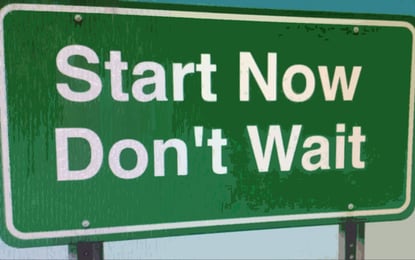The Wall Street Journal featured a review this past Saturday of “Wait: The Art and Science of Delay” by Frank Partnoy (affiliate link) by Christopher B. Chabris. The review highlights Frank Partnoy’s challenge to those espousing the need to act right away, lest opportunities be forever lost and his support for the waiting game strategy in both business and personal lives. The question of using the waiting game strategy is something we have talked about here on Brainzooming before as “strategic patience.”
In “Wait,” Frank Partnoy offers examples of the waiting game strategy paying off in a variety of situations. These include a baseball batter who can wait on getting the right pitch to 3M waiting twelve years between the discovery of a low-stick adhesive and the introduction of the Post-it Notes the adhesive made reality.
As with many books, Christopher B. Chabris points out in his review that Frank Partnoy offers examples, but no answers to know when and how long to wait because “there is no formula for getting the right answer.”
I don’t necessarily have a formula either.
But as one who likes to use the waiting game strategy, thinking back through lessons from both my business and personal lives suggested six characteristics of situations where a waiting game strategy can work and two critical success factors for one being more successful.
Six Characteristics where a Waiting Game Strategy Can Work
Thinking about situations where you are considering waiting over acting, you’re likely to find a waiting game being successful if these six characteristics are in place:
1. Waiting is consistent with a longer-term strategy you have in place
This implies a pre-determined reason for waiting that was baked into your initial strategy.
2. Your longer-term strategy is flexible and can accommodate several situations or time frames
When your strategy could apply to a variety of different market and organizational scenarios, waiting for the best of these is a viable approach.
3. Your opportunity and risk exposure is so small that you are willing and able to sustain the window of opportunity going away completely
This is the classic negotiation technique. If you are in a waiting game, you have to be able to walk away from the deal (or have it walk away from you) and still be okay.
4. You are still learning or receiving benefits while waiting that improve your ability to respond
This reflects the advantage played out by fast followers. Rather than jumping in first and learning by trial and error, fast followers watch the leader and go to school on their mistakes before launching a similar effort.
5. You are able to move forward with actions supporting a definitive path to be pursued later
If you’re able to make progress while keeping your strategic options open, that’s a real benefit.
6. Future options are not being shut down (and in fact be expanding) with the passage of time
As long as you’re in the position of being able to decide your course of action (as opposed to having inaction making decisions for you), waiting can still make sense.
Two Critical Success Factors for Making the Waiting Game Strategy Work
To better ensure you do not miss too many opportunities while you are content to wait, make sure you:
1. Don’t let the opportunity you are waiting on be pushed out of sight, out of mind
You need listening posts to monitor market and competitive actions relative to the opportunity you are waiting on to make sure you actually pull the trigger at the latest and best possible time.
2. Have individuals in your close circle that will instigate for action and keep forcing the issue
You want to make sure that even during a period of strategic patience you have people in your organization who are advocates for taking action. As much as you may be fine waiting for things to play out over an extended period of time, you want someone pushing action to keep you honest.
Don’t wait to share what you think!
What are your thoughts on this idea of strategic patience, a waiting game strategy, and the areas Frank Partnoy is addressing? If you’re someone who pursues it, how do you make it work for you? If, instead, you are a person of immediate action, what works best about that approach for you?
We’re waiting to hear what you have to say! - Mike Brown
If you enjoyed this article, subscribe to the free Brainzooming blog email updates.
The Brainzooming Group helps make smart organizations more successful by rapidly expanding their strategic options and creating innovative plans they can efficiently implement. Email us at info@brainzooming.com or call us at 816-509-5320 to learn how we can help you enhance your strategy and implementation efforts.




